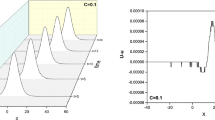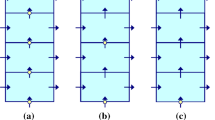Abstract
In this paper, a numerical computation method is proposed to simulate tides in coastal regions. The proposed method is based on the hyperbolic form of governing equations and employs a semi-Lagrangian scheme to ensure the accuracy and stability of numerical computations. Open and wall boundary conditions can be treated universally by combining them with the semi-Lagrangian scheme. Furthermore, the method is applied to some benchmark problems of shallow water to examine its performances in wave propagation, wave transparency through open boundaries, and tides in semi-enclosed bays. The results obtained demonstrate that the proposed method can be utilized as a practical tool to investigate tidal dynamics in coastal regions.
















Similar content being viewed by others
References
Blumberg AF, Mellor GL (1987) A description of a three-dimensional coastal ocean circulation model. In: Heaps NS (ed) Three-dimensional coastal ocean models. American Geophysical Union, Washington, pp 1–16
Chen C, Haung H, Beardsley RC, Xu Q, Limeburner R, Gowles GW, Sun Y, Qi J, Lin H (2011) Tidal dynamics in the Gulf of Maine and New England Shelf: an application of FVCOM. J Geophys Res 116:C12010
Xing Y, Shu CW (2005) High order finite difference WENO schemes with the exact conservation property for the shallow water equations. J Comput Phys 208:206–227
Yabe T, Ogata Y (2010) Conservative semi-Lagrangian CIP technique for the shallow water equations. Comput Mech 46:125–134
Orlanski I (1976) A simple boundary condition for unbounded hyperbolic flows. J Comput Phys 21(3):251–269
Hino M (1988) Review-on numerical scheme of non-reflection and free-transmission open boundary. Tech Rep Dept Civil Eng Tokyo Inst Tech 39:1–5
Chapman DC (1985) Numerical treatment of cross-shelf open boundaries in a barotropic coastal ocean model. J Phys Oceanogr 15:1060–1075
Akoh R, Ii S, Xiao F (2008) A CIP/multi-moment finite volume method for shallow water equations with source terms. Int J Numer Methods Fluids 56:2245–2270
Xiao F, Yabe T (2001) Completely conservative and oscillationless semi-Lagrangian schemes for advection transportation. J Comput Phys 170:498–522
Hoffman JD (1992) Numerical methods for engineers and scientists. McGraw-Hill, New York
Xiao F, Yabe T, Peng X, Kobayashi H (2002) Conservative and oscillation-less atmospheric transport schemes based on rational functions. J Geophys Res 107(D22):4609
Arakawa A, Lamb VR (1977) Computational design of the basic dynamical processes of the UCLA general circulation model. Methods Comput Phys Adv Res Appl 17:173–265
Hino M (1987) A very simple numerical scheme of non-reflection and complete transmission condition of waves for open boundaries. Tech Rep Dept Civil Eng Tokyo Inst Tech 38:31–38
Hino M, Nakaza E (1987) Numerical examination of a new non-reflective boundary condition for a computer simulation of hydraulic wave phenomena. Tech Rep Dept Civil Eng Tokyo Inst Tech 38:39–50
Fujino M, Kagemoto H, Tabeta S, Hamada T (1994) On the usefulness of non-reflective boundary conditions for a numerical simulation of tide and tidal current. J Soc Naval Arch Jpn 175:161–169
Fang Z, Ye A, Fang G (1991) Solutions of tidal motions in a semi-enclosed rectangular gulf with open boundary condition specified. In: Parker BB (ed) Tidal hydrodynamics. Wiley, New York, pp 153–168
Bermudez A, Vazquez MA (1994) Upwind methods for hyperbolic conservation laws with source terms. Comput Fluids 23(8):1049–1071
Zhou JG, Causon DM, Mingham CG, Ingram DM (2001) The surface gradient method for the treatment of source terms in the shallow-water equations. J Comput Phys 168:1–25
Wu D, Fang G, Cui X, Teng F (2018) An analytical study of M2 tidal waves in the Taiwan Strait using an extended Taylor method. Ocean Sci 14:117–126
Author information
Authors and Affiliations
Corresponding author
Additional information
Publisher's Note
Springer Nature remains neutral with regard to jurisdictional claims in published maps and institutional affiliations.
Appendices
Appendix 1
The mathematical treatment for obtaining the analytical solution in [17] is briefly described here.
By applying the perturbation technique, the solution of the 1D shallow water equation can be mathematically obtained under the assumption that the Froude number \( F \) is small.
The initial condition is given as;
where \( H\left( x \right) \) is the water depth in the calm state. The boundary condition is;
The variables (water column height and flow velocity) are asymptotically expanded as power series of the bookkeeping parameter F in the following manner,
Substituting these perturbation expansions into the governing equations, equating the coefficients with the same powers of \( F \), we have the partial differential equations with respect to the expansion coefficients \( \left( {h_{0} ,h_{1} ,h_{2} , \ldots ,u_{0} ,u_{1} ,u_{2} , \ldots } \right) \). Further, the solution of the zeroth order is given by;
The benchmark problem in this study assumes the incidence of a sinusoidal wave at x = 0 m,
where the amplitude of the incident wave is \( dH = 4.00\;{\text{m}} \), and its period is \( T = 43200.0\;{\text{s}} \).
Another assumption of the benchmark is the topographic undulation expressed by the sinusoidal function as,
where \( \left( {A,B,C} \right) = \left( {50.5\,{\text{m,}}\,\,40.0\,{\text{m,}}\,\,10.0\,{\text{m}}} \right) \).
Appendix 2
The linearized shallow water equation is solvable by mathematical techniques (e.g., [16, 19]). In this study, the solution was obtained assuming a constant water depth, denoted by \( h_{0} \). The modeled bay (Fig. 10) is rectangular with an open boundary along \( x = 0 \), and coasts along \( x = L \), \( y = 0 \), and \( y = B \). The variables are assumed to have a common frequency, \( \sigma \), as expressed by the equation: \( \left( {\eta ,u,v} \right) = {\text{Re}}\left\{ {\left( {\hat{\eta },\hat{u},\hat{v}} \right)e^{i\sigma t} } \right\} \), where \( \left( {\hat{\eta },\hat{u},\hat{v}} \right) \) are the complex amplitudes.
The applications of the variable separation and eigenfunction expansion methods yield the solution comprising four modes: positive Kelvin and Poincaré modes, and negative Kelvin and Poincaré modes. Here, the terms “positive” and “negative” indicate wave propagations in positive and negative x-directions, respectively. Though the theoretically exact solution requires the superimposition of infinite numbers of Poincaré modes, the computations in this study truncate the number maximally at N.
The complex amplitudes of the positive Kelvin and Poincaré modes are
and
respectively.
The complex amplitudes of the negative Kelvin and Poincaré modes are
and
The notations \( \left( {A_{n} ,B_{n} ,C_{n} ,D_{n} } \right) \) in the Poincaré modes are defined as
where \( f^{\prime} \equiv {f \mathord{\left/ {\vphantom {f \sigma }} \right. \kern-0pt} \sigma } \) is a dimensionless Coriolis parameter normalized by the frequency σ.
The y-component of the wavenumber of Poincaré modes is forced to have discrete values by the condition that the bay is bounded along \( y = 0 \) and \( y = B \), written as,
The x- and y-components of the wavenumber \( \left( {l_{n} ,\gamma_{n} } \right) \) of the Poincaré modes are related to the frequency (dispersion relation) as follows;
Here, \( \alpha \) defined as
is the inverse of the Rossby radius of deformation.
About this article
Cite this article
Nishi, Y., Taniguchi, E., Niikura, L. et al. Semi-Lagrangian numerical simulation method for tides in coastal regions. J Mar Sci Technol 25, 675–689 (2020). https://doi.org/10.1007/s00773-019-00672-x
Received:
Accepted:
Published:
Issue Date:
DOI: https://doi.org/10.1007/s00773-019-00672-x




